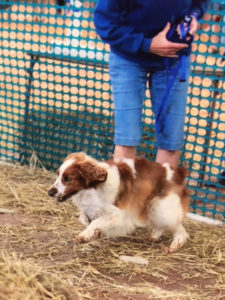That’s the first question I’m asked when I tell people about Pete competing in Barn Hunt trials where he finds rats. The second question is, “They’re LIVE rats?!”
Barn Hunt is a fairly new dog sport based on the talents and skills of rat catchers – humans and their dogs – that would rid farms of rats and other vermin. You’ve probably seen examples of Terriers and other go-to-ground breeds wildly focused on going after their prey. Barn Hunt is a little more controlled and all breeds and ages of dogs can be successful participants. I’ve seen dogs from a miniature Dachshund to a Newfoundland participate in Barn Hunt. Different hunting styles, but both successful!
Picture a fenced-in area, about 20’x20’, with straw bales piled in various configurations. They are stacked two high (in beginning levels) or three high (higher levels), and there is a tunnel made of bales that is either straight, L-shaped, or U-shaped, with up to five turns, depending on the level of competition.
To answer that second question, yes, they are live, hand-raised, well-cared-for rats. They are put in PVC tubes with plenty of ventilation holes and treats. The rats are monitored closely for signs of stress and switched out with rested rats, if necessary. The PVC tubes containing the rats are hidden around the straw bales, covered by loose fluffs of straw. A dog is brought into the ring and released. The hunt is on! The dog has a certain amount of time to accomplish three elements in any order –
- climb on a bale with all four feet
- go through the tunnel
- find all the rats. The number of rats varies with the level of competition, as does the time allotted to find them. There is one more complication: Some of the hidden tubes have just rat litter (bedding) in them or are empty tubes; the dog has to find the actual live rat tubes.
When a dog finds a rat, hopefully they have a definite sign that they have found a live rat. Some dogs are very subtle — they freeze, twitch an ear, change the position of their tail, or cock their head. Other dogs are more demonstrative and pounce on the tube, bark, and dig at it. The handler then calls “RAT!” and, if the dog really did find the tube with the rat, the judge will say “Congratulations!” If the handler calls “RAT!” and it’s not the tube with the rat, the judge will say, “No, I’m sorry,” and you’re done for that round.
 Pete has been to four two-day trials. Our first efforts were not very successful, though he had a lot of fun climbing on the bales and running around the course. But with a little practice with a coach, in what I call “rat class,” he caught on. Pete now talks to me with little chirping sounds and digs at the tube when he’s found the rat. Since last spring, he earned his Novice and Open titles (finding one and two rats, respectively, in three different sessions) and recently earned one leg of three on the way to getting his Senior title (finding four rats in each session).
Pete has been to four two-day trials. Our first efforts were not very successful, though he had a lot of fun climbing on the bales and running around the course. But with a little practice with a coach, in what I call “rat class,” he caught on. Pete now talks to me with little chirping sounds and digs at the tube when he’s found the rat. Since last spring, he earned his Novice and Open titles (finding one and two rats, respectively, in three different sessions) and recently earned one leg of three on the way to getting his Senior title (finding four rats in each session).
You can see from the pictures that Pete is eager to go when released and enjoys celebrating when he’s successful. We have a lot of fun working together, he gets to exercise his good sniffer, we’ve met lots of nice people, and made new friends. That’s a win, even if we don’t get a ribbon!
– Karen & Pete
(Photos by Rob Duberstein)

